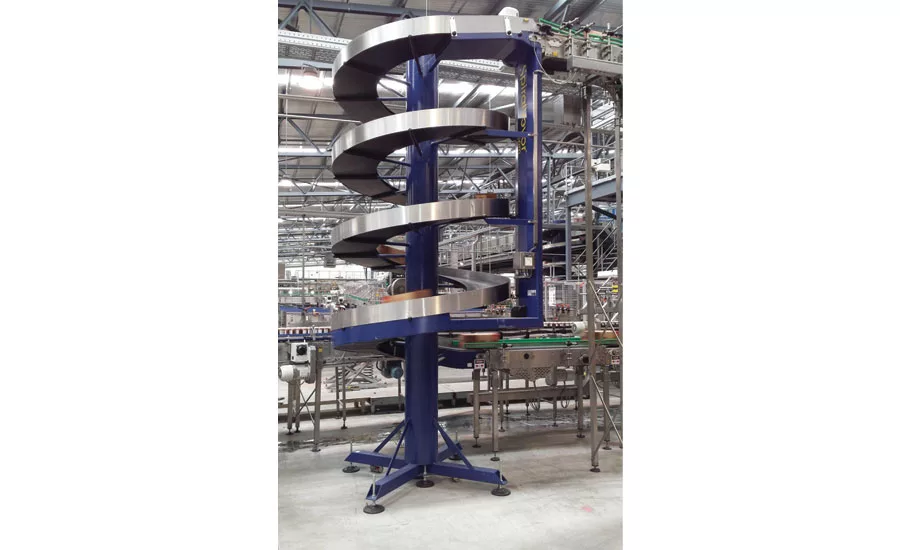‘Essential’ manufacturers rely on conveyors for faster, safer production
Conveyors that boost safety, output speed now in high demand

The SpiralVeyor SV is an all-purpose spiral conveyor for medium- to large-sized products ideal for handling secondary packed products and cases in logistics, using multiple functions from elevation up to accumulation. (Image courtesy of AmbaFlex)
As many businesses are slowing down or halting operations, other manufacturers are ramping up production as online purchasing of daily essentials like food and beverages spikes. Conveyor systems are supporting these changes to the traditional manufacturing supply chain as more is being asked from manufacturers and distributors. As a result, companies in the conveyor business are taking measures to boost internal efficiencies while launching advanced conveyor technologies.
According to its “Conveyors Market: Growth, Trends and Forecast (2020-2025)” report, Hyderabad, India-based Mordor Intelligence estimates that conveyor systems help manufacturers reduce manual labor by 40 percent and increase work efficiency by three-and-a-half times.
“SKU proliferation has greatly contributed to the demand for various packages, such as boxes, standard and mini-bottles, pouches and cans,” says Kritika Mamtani, senior research analyst at Selbyville, Del.-based Global Market Insights (GMI). “As a result, beverage producers should adopt flexible packaging materials and information management systems that allow them to efficiently deal with SKUs, and manufacturers should upgrade their conveyor technology to ensure softer packaging materials such as bottled water are not damaged due to excessive rolling.”
Joseph Miller, chief operating officer at Winneconne, Wis.-based Multi-Conveyor, says that, in addition to increasing demands from the beverage industry, the company also has seen an uptick in demand for food, household and pharmaceutical goods produced. He notes that as these businesses ramp up production and implement new eCommerce solutions to satisfy demand for retail and online products during the COVID-19 pandemic, production must keep up.
“Conveyors are the lifeblood of any mass-automated beverage facility,” he says. “Multi-Conveyor's staff has worked tirelessly to make sure that all of our customers, in any critical demand industry, are running at or beyond, normal capacity.”
Ensuring every aspect of a conveyor system is optimized for quick, efficient production relies on the capabilities of its individual components. Brampton, Ontario-based Van der Graaf (VDG) manufactures drum motors, which house all moving parts of the motor in a sealed oil bath, improving lubrication and cooling.
“While conveyor systems in each industry have specific requirements, all industries demand increasing output and lowering costs,” says Alexander Kanaris, president of VDG. “In addressing recent industry challenges, our focus has been [on] improving our electric motors’ efficiency. We’ve developed higher-efficiency gear reducers and improved the sealing system to eliminate oil leaks, giving the drum motor more efficiency, along with a longer, lower-maintenance lifespan.”
Another important component of conveyors is shape and structure. Spiral conveyors, for example, may convey more product in a given vertical space than other conveyor styles in some manufacturing setups. Experts say they also can consume less energy, use less drives, and reduce the number of motors, as the rolling design of the slat chain can improve movement efficiency.
Phil Miller, president of Arlington, Texas-based AmbaFlex Inc., says that the company offers a spiral conveyor solution specifically designed for beverage operations.
“Our spiral conveyors offer dynamic accumulation solutions for primary pack items, featuring [first-in, first-out] FIFO, no product touching, stable, high speed, and mass flow conveyance for bottles and cans,” he says. “This includes off-line buffering, time-delay solutions, and secondary packaging solutions through robotic palletizing.”
When its comes to throughput, spiral conveyors often can pack more products, as well as taking up less square footage in a warehouse due to their vertical design, he adds.
Safe and sanitary manufacturing
With the unprecedented status of the manufacturing industry right now, product safety must not be sacrificed as a result of increased demands.
Multi-Conveyor’s Joseph Miller says that, along with optimizing its conveyors for efficiency, the company’s products help ensure safety.
“Essential manufacturing companies like ours are on the frontlines, so minimizing any and all risk as we produce our conveyors is our top priority,” he says. “We excel in the manufacturing of sanitary conveyor systems, which may include stainless steel washdown, bolted and continuous weld designs; bolted wearstrips, frame spacers and stand-offs; welded frame spacers and more.
“Our 3A systems are ground and polished to 3A specifications,” he continues. “Also our 2BN finish, which is considered a sanitary finish, is used for applications where there is direct food contact. Sanitary welded designs are 7 ga and 2BN.”
While the company manufactures a variety of conveyors, its sanitary systems currently are in highest demand.
“Sanitary construction may include premium critical radius welds, bolts and radius bushings; gasketed areas to keep contaminants from getting behind wear strips; removable NTR components for washdown, including CIP (clean in place); or agency approved belting, to name a few,” he says. “We follow strict guidelines to ensure the proper sanitary specifications are met for FDA, USDA and USDA Dairy, AMI (or meat), 3A Dairy, BISSC (or bakery), and other agency compliance as required.”
Phil Miller suggests that the industry must ultimately trend toward conveyors that are cleaner, safer, faster, more reliable and technologically advanced to meet current manufacturing needs, especially those of the beverage and food industry segment.
Another example of sanitary conveyor components is the SSV Sanitary Series drum motors VDG produces specifically for food processing and handling applications.
“While conventional conveyor drives use sprockets on a square shaft to drive module-style conveyor belts, the SSV drum motor is an all-316 stainless steel drive with the belt profile machined directly onto the stainless steel drum, eliminating areas for bacterial harborage,” VDG’s Kanaris says.
This helps ensure products at every level of production are meticulously handled, decreasing or eliminating contamination risks and boosting efficiency in the process, he adds.
In it for the long-haul
AmbaFlex’s Phil Miller notes that today’s conveyors are designed with lower power requirements, improved efficiency, lower noise levels, longer wear components and reduced maintenance requirements. While he explains this is nothing new, these attributes have recently gained more attention as customers seek the best value when purchasing spiral conveyor equipment along with the lowest possible total cost of ownership.
“There is always a push to do more with less, improve efficiency, become more ‘green’ in every way possible, think globally, and be the innovative market leader,” he says.
Valued at $7.7 billion in 2019 and expected to exceed $10 billion by 2025, Mordor’s report suggests that the conveyor market will undergo a major transformation due to the globalization of economy, shorter product cycles and eCommerce advancements. Moreover, as the movement of goods and shifting variety in product packaging accelerates SKU growth, manufacturers and distributors are demanding better solutions for labor, equipment and technology for operations, including conveyor systems within the beverage industry.
VDG’s Kanaris says that although the COVID-19 pandemic is threatening the economy as we have known it, it has also revealed how dependent U.S. production is on an overseas supply chain, projecting that domestic manufacturing will continue to grow.
The recent uptick in online retailing, coupled with changing consumer behavior, is likely to positively impact manufacturers’ adoption of conveyor and sortation systems. As they strive to ensure speed and safety standards amidst higher production volume, the outlook and demand for conveyors is expected to rise, experts note.
Looking for a reprint of this article?
From high-res PDFs to custom plaques, order your copy today!






